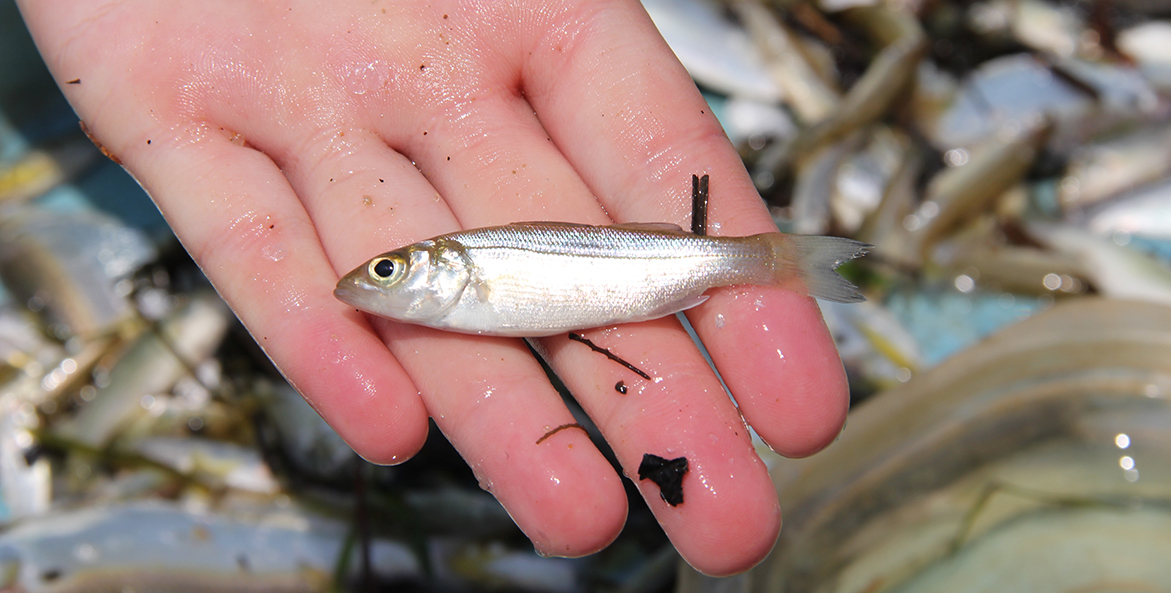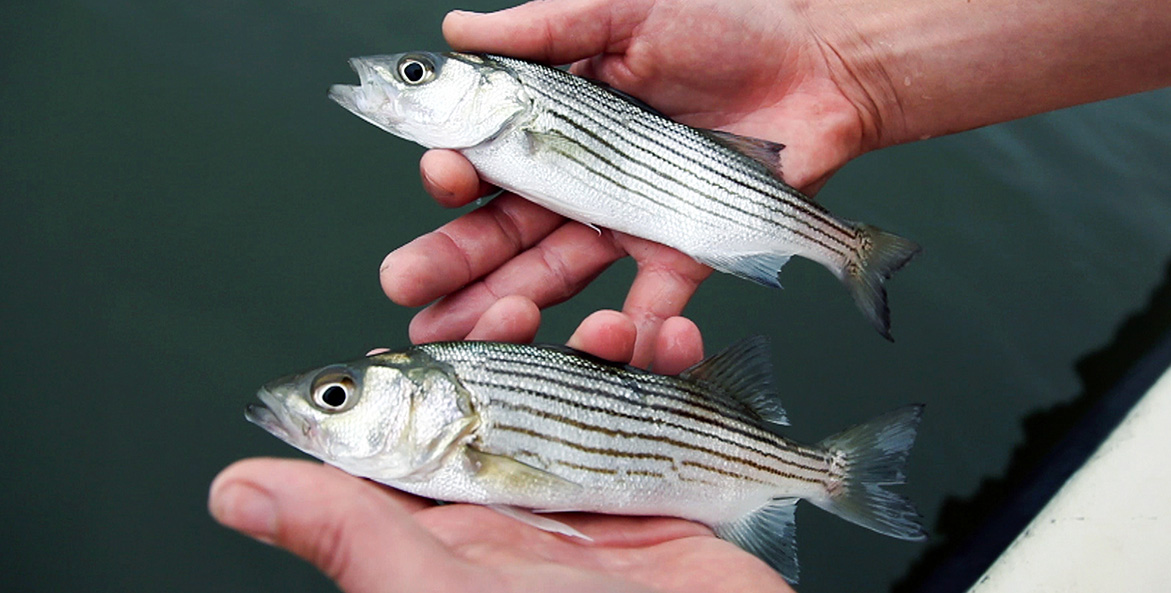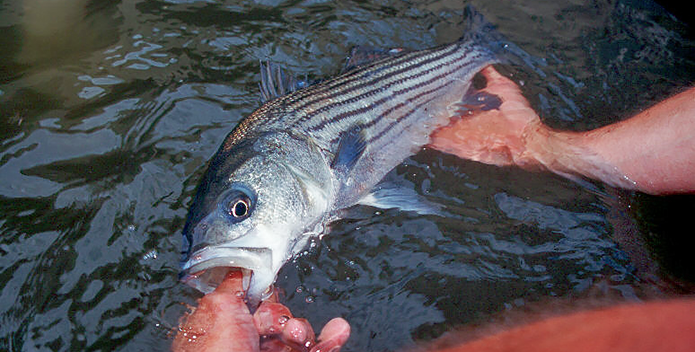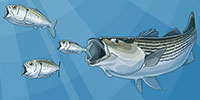December 16, 2024—Striped bass will not receive additional protection for the 2025 fishing season, the Atlantic States Marine Fisheries Commission (ASMFC)’s Striped Bass Management Board determined today. Read the press release.
What are Striped Bass (a.k.a. rockfish)?
Striped bass, more commonly called ‘rockfish’ or ‘stripers,’ are perhaps the most iconic fish in the Chesapeake Bay region. Distinguished by the dark horizontal stripes on their silver bodies, rockfish can live up to 30 years and reach over five feet in length. They migrate up and down the East Coast, but most are born in the Chesapeake Bay and its tributaries and play an important role as a top predator in the Bay ecosystem. They are prized by recreational anglers and commercial fishermen alike.
Why Are Rockfish Important in the Chesapeake Bay?
Rockfish are a crucial part of the Chesapeake Bay ecosystem. Their local name comes from their habit of hiding among oyster reefs and rocks, where they feed on smaller fish, such as bay anchovies or menhaden and crustaceans like juvenile crabs and shrimp. They are also a big economic driver in Chesapeake Bay communities, where they are the focus of popular fishing tournaments, recreational fishing charters, and commercial fisheries.
What Is the Current State of Rockfish Populations in the Chesapeake Bay?
An annual survey of the juvenile striped bass population in the Chesapeake Bay, released in October 2024, shows that for the sixth consecutive year in Maryland and second consecutive year in Virginia, juvenile striped bass numbers are well below average. The most recent data from the Atlantic States Marine Fisheries Commission (ASMFC), the interstate cooperative that manages rockfish, 2022 stock assessment found that the striped bass population along the Atlantic Coast is no longer experiencing overfishing, but numbers remain below the management threshold, indicating further rebuilding of the population is required. In May 2023, the ASMFC instituted an emergency action to decrease the maximum size limit for most striped bass fisheries. That was followed in January 2024 with an update to Addendum II, which made further changes to the recreational and commercial fisheries.
Why Are Rockfish Populations Struggling?
Rockfish are often seen as a great fisheries management success story in the Chesapeake Bay. Populations plummeted in the 1970s and early 1980s due primarily to overfishing. But by 2004, they had rebounded to historic levels thanks to intensive conservation efforts that included restocking programs, a harvest moratorium in Maryland and Virginia, and rigorous interstate management plans that have continue to include specified seasons and size restrictions. Concerns about additional declines in recent years led to The recent changes noted above.
Among the challenges facing rockfish populations, are
- Not enough menhaden. Menhaden, a small fish in the Chesapeake, are a primary prey species of rockfish. But menhaden reproduction in the Chesapeake Bay remains a concern, and many are being caught by an industrial fishing fleet to create fish feed, fish oil pills, and other products.
- Low oxygen levels. Pollution flowing into the Bay feeds large algal blooms, which suck up oxygen when they die and decompose. The result are dead zones, which are areas of the Bay where waters do not contain healthy levels of oxygen for rockfish and other aquatic species. Dead zones can stress rockfish and trap them in warmer waters than they prefer, making them more susceptible to diseases like mycobacteriosis.
- Climate change. Higher water temperatures, low oxygen levels, and changing rainfall patterns due to climate change are having a negative impact on the availability of suitable habitat and are a growing concern for the Chesapeake’s striped bass population. More than 60% of striped bass coastwide are spawned in Chesapeake Bay, making it the primary nursery habitat. Warmer waters may be leading to reduced spawning success while also increasing stress and reducing the growth of young striped bass.
- Handling stress from recreational fishing. Due to stress and injuries, nine percent of rockfish released alive die on average, resulting in millions of dead fish each year. This is an area where recreational anglers can be an important part of restoration efforts.
What Can Be Done to Help Rockfish in the Chesapeake Bay?
Bold action continues to be needed, both by fishery managers and regarding work to reduce nutrient pollution in the Bay, in order to rebuild the population.
First, as noted above, the ASMFC continues to take actions to manage the striped bass fishery.
Second, the ASMFC took action to ensure more menhaden, one of rockfish’s top prey species, are available to support a recovering population.
While these measures are important, it is up to Maryland and Virginia to implement management actions that effectively limit rockfish mortality and improve their habitat, thereby providing the best conditions to get rockfish populations back on the right track.
In addition, the Maryland Department of Natural Resources noted that nutrient pollution reductions made to date in the Chesapeake Bay watershed have prevented more severe degradation of striped bass habitat than would have happened without those actions. It is more important than ever that state and federal partners accelerate efforts to reduce pollution to the Bay to help mitigate these impacts.
What is CBF Doing to Help Rockfish?
CBF has advocated for years for science-based fishery management that takes the functioning of the Bay ecosystem into account. In 2020, after decades of work by CBF and partners, the ASMFC took an important step to help rockfish by increasing protections for one of their primary food sources: Atlantic menhaden.
ASMFC adopted what are known as ecological reference points to help determine how many menhaden can be harvested while still leaving enough food for rockfish and other fish and wildlife. Ecological reference points use scientific models to reflect how changes in the menhaden population affect populations of the fish that eat it—allowing fishery managers to quantitatively say how many menhaden are needed to feed and sustain our desired populations of those predator species.
The ecological reference points adopted by ASMFC specifically focus on keeping enough menhaden in the Bay to sustain rockfish populations. Of all the predator species studied, rockfish was shown to be the most sensitive to changes in the menhaden population. Therefore, adopting ecological reference points that protect rockfish will also protect other predator species.
This important action will not recover the rockfish population on its own, but it will help ensure the rockfish in the Bay have enough to eat. Other critical work includes:
- Restoring oyster reefs in the Bay. Oyster reefs help filter the water and provide important habitat for rockfish and other fish species. CBF operates oyster restoration centers in Maryland and Virginia to grow and place millions of juvenile and adult oysters in the Bay each year. As a member and coordinator of the Chesapeake Oyster Alliance, we are working together with a diverse array of partners toward the ambitious goal of placing 10 billion oysters in the Bay by 2025.
- Reducing nutrient pollution that drives low-oxygen dead zones. CBF is working on the ground across the Chesapeake Bay watershed to implement the Chesapeake Clean Water Blueprint, the historic federal/state plan to stem the flow of nitrogen, phosphorus, and sediment into Bay waters from farms, cities, wastewater treatment plants and septic systems, and other sources of pollution. We also work to hold the government and polluters accountable to the Blueprint through advocacy and, when necessary, litigation.
- Addressing climate change. Fighting climate change and its impacts, including warming water temperatures, is essential to help sustain rockfish in the long term. From helping farmers implement regenerative agricultural practices to planting streamside forest buffers and advocating for clean air regulations, much of CBF’s work to save the Bay has the dual benefits of reducing pollution and fighting climate change.
Five Ways YOU Can Help Rockfish Recover in the Chesapeake Bay
There are many ways you can help us restore rockfish populations and improve water quality in the Bay.
- Use safe fish handling practices. Due to stress and injuries, approximately nine percent of rockfish released alive die, resulting in millions of dead fish each year. To increase survival rates, anglers can use these best practices for catch and release.
- Spread the word to your neighbors and friends about why rockfish are important to the health and economy of the Chesapeake Bay.
- Share your support for science-based rockfish management by writing a letter in your local paper or to state officials responsible for fishery management.
- Volunteer with CBF restoration programs, including oyster restoration projects, tree plantings, and more.
- Make a donation to help us continue our critical work to restore and protect rockfish populations and water quality in the Bay.
News
-

ASMFC Considers Further Conservation Action Following Updated Striped Bass Stock Assessment
October 24, 2024
The Atlantic States Marine Fisheries Commission (ASMFC) reviewed results from its coastwide 2024 Striped Bass Stock Assessment update, which indicated that fish numbers remain below sustainable levels, and voted to meet again in December to consider further action.
-

Young Striped Bass Continue Years-Long Struggle in Chesapeake Bay
October 17, 2024
Today the Virginia Institute of Marine Science (VIMS) and the Maryland Department of Natural Resources (DNR) released another year of alarming results from an annual survey of juvenile striped bass in the Chesapeake Bay.
-

Between a Dead Zone and a Hot Place
August 20, 2024
Rising water temperatures and low-oxygen areas are yet another stressor for striped bass—especially young striped bass—in the Chesapeake Bay during summer. While management actions are the most immediate way to help striped bass, addressing chronic problems like the dead zone remains critical to the species’ long-term prospects.
| Items 4 - 6 of 6 | Previous | 1 | 2 |




